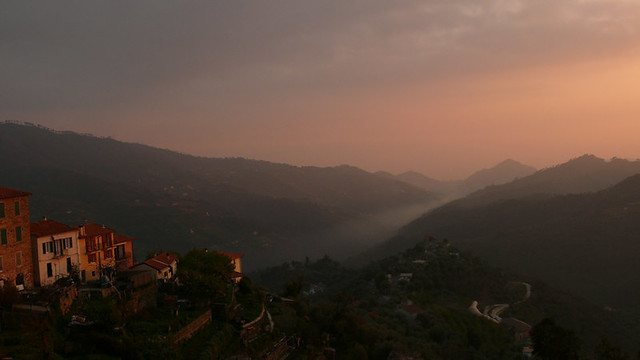By the time you curl down from Monte Bignone to the castle-crowned village of Perinaldo, perched at a 1,800 feet above the Nervia Valley, you might well feel dizzy.
On the upside, you will almost certainly understand why, in the blood-soaked Middle Ages, the Ligurians retreated to places like Perinaldo: the isolation is total, the views of approaching enemies are unobstructed, and there is free building material to boot. Everything is stone.

Photo courtesy Agata Janus, All Right Reserved
British travelers of the mid-1700s doing the Grand Tour in Italy “discovered” Italian Riviera redoubts such as Perinaldo, dubbing them “Rock Villages,” largely because they are hewn out of the mountainsides and blend into them.
It also becomes clear very quickly why Perinaldo’s most famous native son, Gian Domenico Cassini, born in the village castle in 1625, became the world’s greatest astronomer. He grew up in a crow’s nest. If you glance skyward once you’ve parked your car you might even spot the Cassini Equinox NASA spacecraft, still photographing and heading toward Saturn and Titan.
You’d need super-powerful lenses—or the eyes and imagination of Cassini himself.
Like most Ligurian perched villages Perinaldo spreads its red-tile roofed, pastel-painted houses across a ridge. That means lots of sun year round and sightlines down V-shaped valleys to the sea (where pirates once lurked) and up to the Alps (Hannibal or Napoleon).
The 11th-century stone houses are built like fortresses with flying buttresses, the alleys between them moats. Unfortunately it seems several penny-pinchers are among those gentrifying Perinaldo: cracked cobbles and worn stone walls have been replaced here and there with cheap tile and brick.
A mega-magnitude earthquake in 1887, followed by the abandonment of the countryside during the industrial revolution, led to the village’s decline. There are still a few abandoned buildings. Those that have been spruced up sport foreign names on the doors, nearly all German or French, including many IT professionals or artists.
The fulltime Italian inhabitants of Perinaldo are in part descended from Calabrians. The hybrid Ligurian-Calabrian dialect spoken by some villagers can seem impenetrable.
“The Calabrians were the only ones desperate enough to move up here and re-colonize the place when times were bad,” explained an elderly gentleman at a local café. “We moved in here and half a dozen other disaster sites….”
Beyond Apricale and Baiardo, other nearby western Ligurian ghost aeries include Triora, famed for its medieval witch-hunts, and Bussana Vecchia, now a self-styled “artists’ colony.” But they’re less “authentic,” i.e. lived in primarily by Italians, than Perinaldo.
Cassini is one of the old clans based here. It turns out there are still many families with the name, and they total about 900 of the residents.
The view and atmosphere aren’t the village’s only attractions: the food here is outstanding. The local version of Ligurian “pansoti” take the form of deliciously delicate purses of pasta stuffed with wild field greens. A favorite main course is rabbit sautéed with pine nuts and herbs.
The village castle, in private hands, isn’t open to the public, but the church of San Nicolò is. A Renaissance structure with Baroque overlay, its treasures include a 15th-century “school-of” canvas (depicting souls in various attitudes of salvation or damnation) that would be unremarkable had it not been left to villagers by the great Cassini himself.
Like most ambitious locals, Cassini made good elsewhere, becoming official astronomer to Louis XIV’s court in Versailles and creator of the Paris Observatoire. It was there he discovered satellites of Saturn and Jupiter, and calculated the rotation period of Mars. The French lay claim to Cassini of course, since he fathered another famous French astronomer (Jacques Cassini) who did likewise (César François Cassini) and so on, until a fourth astronomer-topographer (Count Jacques Dominique de Cassini) put an end to the line. Perinaldo’s humble observatory, in a reconverted convent that now houses the town hall and a rest home, is open to stargazers by appointment.
Footpaths and mule tracks embroider the terraced hills around Perinaldo. Until the early 1900s they were the only link to the outside world. For a breathtaking hike you can wander down a stony track to Dolceacqua, a village in the valley below. The trail offers about 4 miles of scenic switchbacks among olive groves, featuring views of castles and sanctuaries-in-the-air.
For addresses and opening hours, and much more on Liguria, its history, culture, food, wine, hiking trails, treks, guided tours, restaurants, food shops, best coffee, best focaccia and more, keep reading WanderingLiguria and pick up our books, Food Wine Italian Riviera & Genoa and Enchanted Liguria: A Celebration of the Culture, Lifestyle and Food of the Italian Riviera
Take a private custom tour with us in Genoa, on the Riviera, in Rome, Paris or Burgundy
Great article, it was such fun to take trip back in memories. Thanks for sharing!
— gagatka · Dec 9, 06:27 AM · #